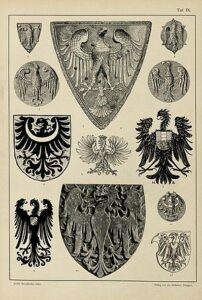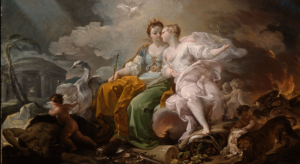In modern, mainstream linguistics, metaphors and symbols do not have anything to do with each other. Metaphors are by definition motivated, no matter which theoretical approach to them one might have. One can, as Aristoteles did, treat a metaphor as the rhetoric trope comparatio in absentia (an “absent” or implicit comparison), allowing to refer to for example ‘government’ by ‘yoke’, based on a common quality (the tertium comparationis, third element of the comparison, e.g. ‘suppression/power over’). One can follow Black and lay emphasis on the interplay between focus and frame. Or one can be interested, as Lakoff and Johnson, in the so-called conceptual metaphor as a cognitive tool helping to understand one conceptual domain in terms of another conceptual domain. All these approaches to metaphor have in common that they regard this phenomenon as semantically/cognitively motivated. As to symbols, most linguists follow Charles Saunders Peirce and/or Ferdinand de Saussure in defining a symbol as a sign that points to its referent by convention, i.e. arbitrarily, i.e. as a non-motivated sign. Words in languages count as symbols, and even if there are numerous examples of motivated words, from onomatopoetic words (to meow, to splash) to (inside a language system) derived (heart > hearty) and compound words (heart attack), the basic understanding of a symbol in linguistics remains that of being non-motivated.
However, the term symbol can also be applied to pictorial representations (and not “words” of a language). Symbols of this kind can also be called emblems and are always motivated, such as a cross for Christianity. Not distinguishing between ’symbols as words of a language’ and ’symbols as emblems’ can lead to unwarranted short circuits even in scientific theorization: very often, archaeologists infer the use of ”symbolic language” in prehistoric homo populations (homo sapiens, homo neanderthalensis) from the use of material objects as e.g. shell beads. Even if the latter are used as emblems (and not merely as expression of aesthetic pleasure rooted in pattern recognition), there remains a huge semiotic gap between emblematic and symbolic (word) thinking. But this is another and longer story.
It is also easy to confuse ‘symbols as emblems’ with metaphors. The former, just like the latter, involve two parts and a relation between them. The difference is clear, however. The difference between a metaphor, as you know the term from Lakoff and Johnson – but probably also in general – and a symbol-emblem could be put a little bluntly like this: Metaphors are constructions which make us understand or conceptualize one thing in terms of another thing. When the poet André Breton says “my wife whose waist is an hourglass”, he elicits the representation of her waist in such and such way, he highlights a property of his wife. When Romeo says “Juliet is the sun”, he produces an understanding of Juliet in terms of certain aspects of the sun. When one says “we are stuck in this argument”, they conceptualize an argument as a movement from source to goal along a path, etc. Note that the metaphor does not refer to anything, it provides understanding of the thing we are talking about, but it does not have any referential function (the elements that refer in the sentences above are “my wife”, “waist”, “Juliet”, “we”, “argument”).


Symbol-emblems, on the other hand, do refer. Their referential function is key. A cross refers to Christianity (see picture 1). Note that a cross does not tell us anything about Christianity, it is not a way of conceptualizing Christianity or of highlighting aspects of what we understand by Christianity (as is the case for the metaphorical expressions above). An eagle refers to power – it does not tell us anything about power, it does not shape the concept of power, it just means: “This is power” (see picture 2); it does not mean “Power is an Eagle”.
Now, to make things a bit complicated: we mentioned above that all symbol-emblems are motivated, and one of the motivations can be grounded in … metaphor; that is to say that humans do not pick up a thing as a symbol-emblem for something else without any reason. For example, if we have chosen eagles, and not larvae or sea cucumbers, as a symbol for power, it may be due to the conceptual metaphors “Power/Control is Up”. But do not confuse the metaphorical origin of a symbol with its actual function: It is still there just to refer to power, not to conceptualize Power in Eagle-terms.
Not all symbol-emblems are metaphorically grounded. The cross for Christianity is metonymically grounded: a (significant) part of Jesus’ life has been chosen to represent the whole thing he allegedly gave rise to. The heart has been chosen to represent love because it was thought to be the organ housing such feelings.
Unfortunately, both in the study of the fine arts and in literature studies (and in everyday speech), metaphors and symbols (both as concepts denoted by words and as pictorial emblems) are often used indistinctively: “the eagle in this picture/in this story is a metaphor for power, it symbolizes power”. The sharp semiotic distinctions made above are not a part of the habitual discourse, which can be confusing.
The situation gets even more complicated by the fact that certain (both literary and/or pictorial) genres, such as allegory, parable, fable, are defined by being “metaphoric” or “symbolic” as a whole. Texts belonging to these genres all have a second meaning alongside the literal one. In theoretical descriptions, they are often defined as “symbolizing” abstract messages by concrete content, and equally often as “based on metaphors”. They are also called “extended metaphors”. Allegories also exist as pictorial genres, often as personifications of abstract concepts (see picture 3). We do not regard these genres as based on metaphorical but rather analogical thinking, as they build upon supplying more concrete counterparts to concepts that are more abstract, but without involving the tertium comparationis we mentioned in the beginning, i.e. the invoked aspect of the first thing that helps us conceptualize the other thing. It is hence important to note that other scholars often work with a looser definition of metaphor, namely anything involving a second reading beside the literal one.

To sum up: metaphors help us conceptualize one thing in terms of another, which is why they are always motivated. Symbols conventionally refer to concepts, entities or institutions and can be verbal or pictorial. Verbal symbols (words) can be and very often are arbitrary (at least if you abstract away from their etymology), while pictorial symbols (emblems) are motivated (often grounded in metaphor or metonymy). That is why, in the discourse of (particularly) pictorial art analysis, the line between the concepts symbol and metaphor can be blurred.
***
Alexandra R. Kratschmer is an Associate Professor at the Linguistics Department at Aarhus University.
Peer Bundgaard is an Associate Professor at the Cognitive Semiotics Department at Aarhus University.
This article is a product of the course “Cognitive Analysis: Picture and Text”, co-taught by the authors in the spring of 2019.
Further Reading
Aristotle. On Rhetoric – A Theory of Civic Discourse. Translation by George A. Kennedy. 2006. 2nd edition. Oxford University Press.
Bergman, Mats and Sami Paavola. 2014 (2003). Peirce’s Terms in his Own Words. Commens. http://www.commens.org/dictionary
Black, Max. 1954-1955. Metaphor. Proceedings of the Aristotelian Society, New Series, Vol. 55. 273-294.
Henshilwood, C., d’Errico, F., Vanhaeren, M., van Niekerk, K., & Jacobs, Z. 2004. Middle Stone Age Shell Beads from South Africa. Science 304 (5669). 404.
Lakoff, George and Mark Johnson. 1980. Metaphors we live by. University Chicago Press.
Saussure, Ferdinand de. 1995 (1916). Cours de linguistique générale. Critical edition by Tullio De Mauro, Paris: Payot.






Have you ever wondered if the eagle truly represents power or if it’s just a symbol? Let’s discuss!